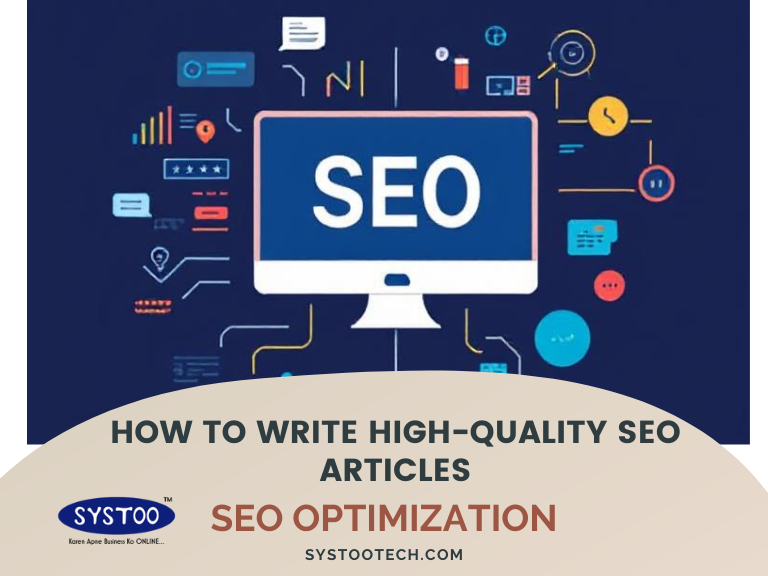Introduction
In today's digital world, SEO (Search Engine Optimization) is crucial in content marketing. Businesses and bloggers rely on SEO-friendly articles to drive traffic, improve rankings, and engage readers. But what exactly makes an article "high-quality" in SEO terms?
A well-optimized article ranks higher on Google and other search engines and provides value, readability, and engagement. This guide will teach you how to write content that attracts search engines and human readers, ensuring higher traffic and conversion rates.
Understanding SEO Basics for Content Writing
What is SEO?
SEO, or Search Engine Optimization, is the practice of enhancing online content to improve its visibility on search engines like Google, Bing, and Yahoo. The goal is to rank higher in search results and attract organic traffic.
How Search Engines Rank Content
Search engines use complex algorithms to determine rankings. They analyze factors such as relevance, keyword usage, backlinks, readability, and user engagement.
Difference between On-Page and Off-Page SEO
• On-Page SEO: Involves optimizing elements within the article, such as keywords, headings, and Meta descriptions.
• Off-page SEO: Focuses on factors outside the content, including backlinks, social signals, and domain authority.
Keyword Research: The Foundation of SEO Articles
Why Keyword Research Matters
Keywords are the bridge between what users search for and the content you create. Proper research ensures you target high-traffic, low-competition phrases.
How to Find the Right Keywords
• Use Google Autocomplete and People Also Ask sections.
• Analyze competitor content using SEO tools.
• Target a mix of high-volume and niche-specific keywords.
Best Keyword Research Tools
• Google Keyword Planner (free)
• Ahrefs (premium)
• SEMrush (premium)
• Ubersuggest (free & paid options)
Long-Tail Keywords vs. Short-Tail Keywords
• Short-tail keywords: "SEO tips" (high competition, broad search intent)
• Long-tail keywords: "best SEO article writing strategies for beginners" (lower competition, targeted audience)
Creating a Strong Article Structure
Importance of Organizing Your Content
A well-structured article improves readability and SEO performance.
Headings and Subheadings for SEO
Use H1, H2, H3, and H4 tags properly:
• H1: Main title (used once per article)
• H2: Section headings
• H3-H4: Subheadings for further organization
Using Bullet Points and Lists
• Increases scannability.
• Helps Google feature snippets.
• Improves user experience
Writing SEO-Friendly Headlines That Grab Attention
Characteristics of an Engaging Title
• Must be clear, concise, and informative.
• Includes a target keyword.
• Uses power words to attract clicks (e.g., "Ultimate Guide", "Best Strategies").
Examples:
✅ "How to Write SEO Articles That Rank #1 on Google"
✅ "10 Proven SEO Tips to Boost Your Blog Traffic"
Crafting an Engaging Introduction
How to Hook Readers Instantly
• Start with a question, statistic, or bold statement.
• Clearly state the purpose of the article.
• Naturally include keywords within the first 100 words.
Writing High-Quality, Valuable Content
Why Content Quality Matters for SEO
Google prioritizes valuable, well-researched content over keyword-stuffed, low-quality articles.
Avoiding Keyword Stuffing
❌ "Best SEO article writing SEO tips for SEO success."
✅ "Here are the best tips for writing high-quality SEO articles."
Optimizing Content for SEO
Proper Keyword Placement
• Title & Headings
• First 100 words
• Meta description
• Image alt text
Using Synonyms & LSI Keywords
Latent Semantic Indexing (LSI) keywords help search engines understand content relevance.
Using Images, Videos, and Other Media for SEO
Optimizing Images
• Use alt text for image descriptions.
• Compress images for faster load times.
• Add relevant file names.
Benefits of Embedding Videos
• Increases time on page.
• Boosts engagement and shares.
• Improves SEO rankings.
The Power of Meta Descriptions and SEO Titles
How to Write Compelling Meta Descriptions
• Keep it under 160 characters.
• Include target keywords.
• Make it persuasive.
Common SEO Mistakes to Avoid
❌ Overusing keywords
❌ Ignoring mobile optimization
❌ Forgetting meta tags & descriptions
Conclusion
Writing high-quality SEO articles takes time and strategy. By following these tips, you’ll create valuable, engaging, and search-optimized content that ranks well on Google and attracts readers.
Start optimizing your content today!







Comments (0)